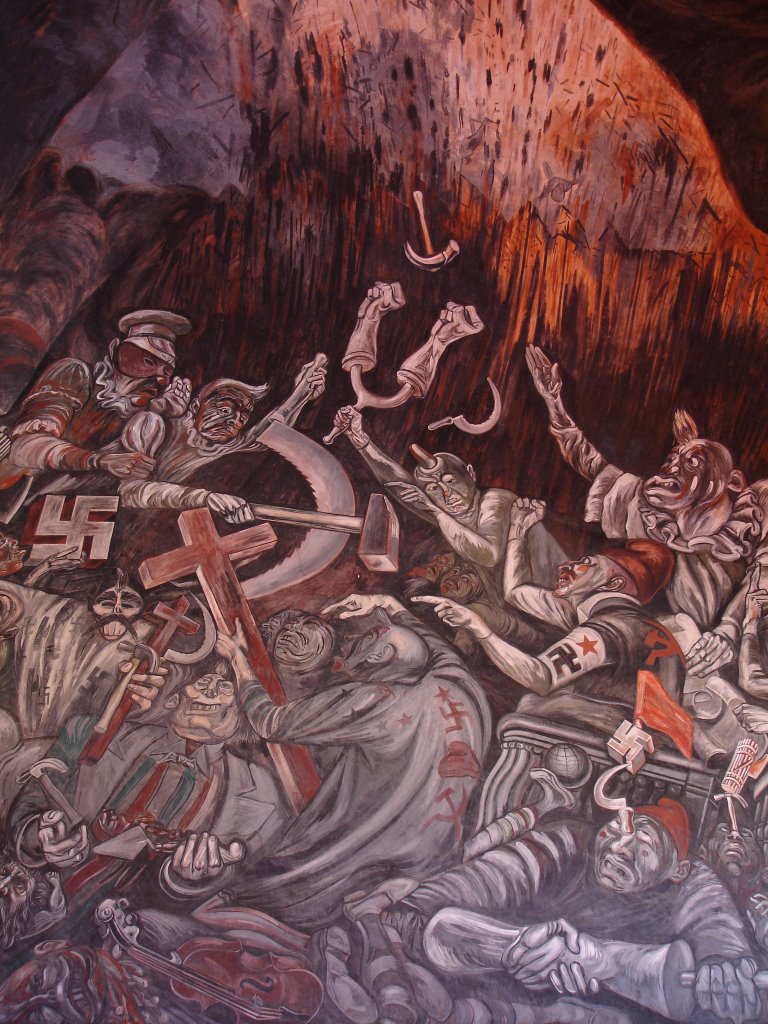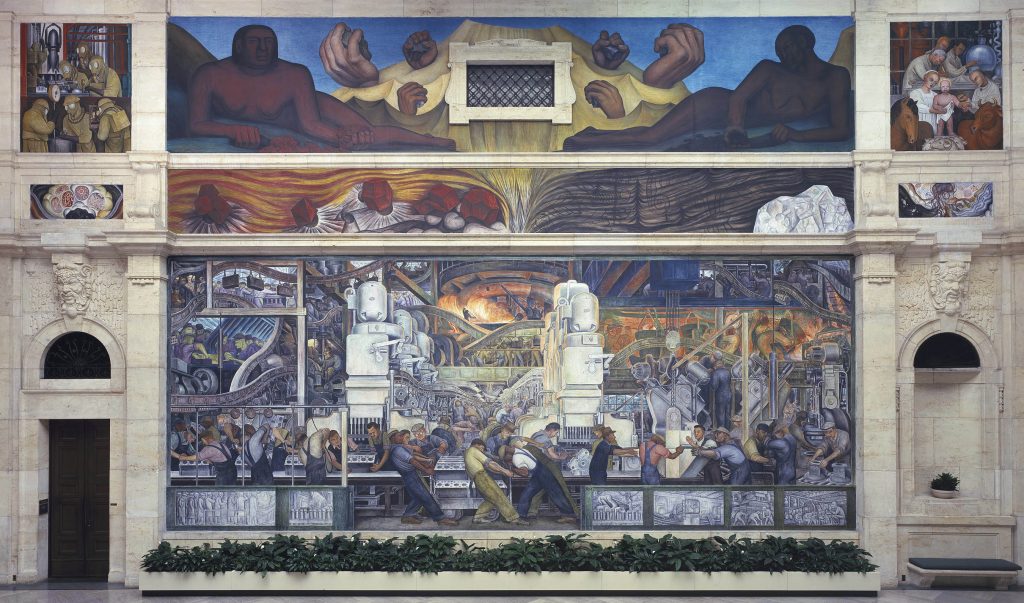In: Mexican artists

José Clemente Orozco | The Clowns of War Arguing in Hell, 1944
October 6, 2022José Clemente Orozco | The Clowns of War Arguing in Hell, 1944
Fresco, Palacio de Gobierno, Guadalajara (alternately known as Carnival of the Ideologies).
Do I look like the kind of clown that could start a movement? (from the film Joker, 2019)
And butchered, frantic gestures of the dead. (Siegfried Sassoon, 1886 – 1967)
This fresco, created only five years before the artist’s death, is a good example of how ‘Orozco’s late works were characterized by a deep sense of anguish and pessimism as the artist grew skeptical about the future of humanity in the wake of sweeping technological advancements.’ (from here) The facile art historical reading is that this work was Orozco’s reaction to WWII, but even a quick perusal of his impressive body of work, and the cultural and social milieu he existed within, will indicate that this is a more complex and personal artwork than that.
It is, bluntly, a horrifying piece, and intended to be so: painted in the final days of WW II, one might see this as the answer to that image of the conference at Yalta, with FDR, Churchill and Stalin, still pretending to be allies and not with their knives out to gluttonously divide the spoils of war.
Recently I was lucky enough to write about the work of Orozco’s colleague Rufino Tamayo, who eschewed the political discourse that this artist – and other contemporaries like Diego Rivera or David Alfaro Siqueiros – considered essential to Mexican art. Orozco is at the opposite end of this spectrum from Tamayo: in this regard, Octavio Paz [the internationally renowned essayist and poet] once remarked “Orozco never smiled in his life.” (from here) Perhaps that is because – as with this work – Orozco had little use for genteel diplomacy, and knew that once you saw horrors, it was a conscious act of morality to not look away….I am also researching the Russian – Canadian artist Paraskeva Clark, right now, and her aesthetic was to respond to, and reflect, the world she lived within. That is what Orozco is doing here.
But if I’m honest, the reason this older work holds my attention now and I want to share it here is because it seems that very little has changed, in our political discourse, and that we’re still – willingly or press-ganged – onto Das Narrenschiff [A Ship of Fools], a favourite theme of Hieronymous Bosch and so many others….
A quick perusal of the civic candidates standing for office in my space of Niagara only emphasizes this appropriate cynicism.
Much more about Orozco’s life and legacy can be seen here.
~ Bart Gazzola
Read More
Diego Rivera | The Detroit Industry Murals
November 19, 2021Diego Rivera | The Detroit Industry Murals, 1932 – 1933
Diego Rivera’s work in the Detroit Institute of Arts, titled The Detroit Industry Murals, is one of the finest works of art of the 20th century, and easily one of the finest examples of a mural ever; it’s not inappropriate to appreciate it as the apex of the Mexican artist’s career, and it functions as a significant touchstone of not just the history of Detroit, but of North America and larger issues and ideologies that were dominant at the time of its creation but that still are prevalent now.
“Between 1932 and 1933, Diego Rivera completed this series of twenty-seven fresco panels entitled Detroit Industry on the walls of an inner court at the Detroit Institute of Arts. It was commissioned by capitalist Edsel Ford but conceived by the Marxist artist as a tribute to the city’s industries and labor force. Rivera used the Ford motor plant in Dearborn Michigan as the model for the industry murals. This plant, the Rouge Plant, spread all along the Rouge River, had a steel mill, glass factory, and auto assembly line. By the time Rivera visited these plants, the depression was in full swing but Rivera didn’t record accurately aspects of the Depression. Note, for example the predella panel where workers are lined up to receive their pay in front a parking lot filled with cars, a scene he would not have observed since the work force had been dramatically reduced. In addition to the automobile industry, Rivera chronicles the history and development of various other industries in the area.
At various times the murals have been controversial. Initially, some critics focussed on Rivera’s communism asserting that he had painted a communist manifesto. Others complained that the workers were depicted as dehumanized in the murals, even though most workers saw themselves as represented with dignity. Some complained that the nudes on the East wall were pornographic and saw the “Vaccination” panel as sacrilegious. Later, during the McCarthy era, a large sign was placed in the courtyard with the murals defending the artistic merit of the murals while attacking Rivera’s politics. More recently, a case has been made that the cycle is universal, reflecting “not only the essence of the industrial culture of Detroit but also a belief in technology and science that is operative today. As such, it is a history-making work of art in which the working class and industrialists both find affirmation.” And the aesthetic value of the series is no longer in doubt; many believe that this series of frescoes represent the best of Mexican mural art in the United States.”
This work also has to be seen as part of a larger series, including Rivera’s harsh Frozen Assets (1931 – 32) but also informing Self-Portrait on the Borderline between Mexico and the U.S. (1932) by Frida Kahlo, as they were a duo who contested and completed each other in their painting and ideologies. It’s also good to consider that too often, when engaging with art we privilege interpretations based upon ‘where’ we stand; this work – and the other ones I’ve mentioned by Rivera and Kahlo – looks at the United States with the eyes of an outsider (as I did, too, when I first visited it).
As a 19 year old new to the city of Detroit (and having my first real experience of the United States), The Detroit Industry Murals awed me (both in seeing the skyscrapers and trappings of the downtown that was the legacy of those glory days, and in stepping outside that bubble to the wasteland and abandoned industrial plants like detritus of a ‘better time’). To stand in the middle of the room, and be enclosed by these works, was a defining experience regarding both the possibilities and responsibilities of art. I’m offering a sampling of images here, but more can be enjoyed at this site: but truthfully, you must see this in person, in the downtown of Detroit, with all of its intersecting and contradicting narratives, and stand it its presence….
More images from this seminal work by Rivera can be seen here (and the long quote in this essay is also taken from there). ~ Bart Gazzola
Read More
Recent Comments